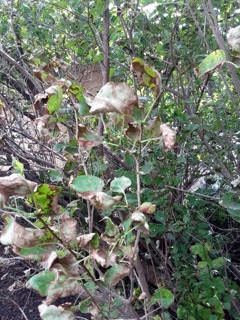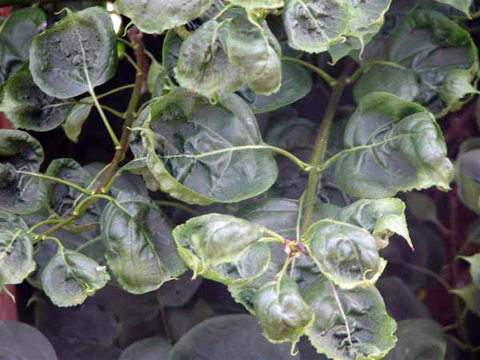Quick facts
- Common lilacs (Syringa vulgaris) are long-lived plants.
- Lilacs are susceptible to fungal leaf diseases, most of which cause only cosmetic damage to leaves.
- The severity of leaf spot diseases can be reduced by proper care (pruning, mulching, watering) and sanitation (cleaning up fallen leaves).
- Always ask for disease-resistant plants when choosing new plants for your property.
Fungal leaf diseases of lilac
Fungal leaf diseases like Septoria and powdery mildew can cause concern as people watch the leaves of otherwise healthy lilacs (and sometimes other shrubs) turn yellow, then brown, and then drop to the ground.
Cool temperatures and wet, windy conditions spread fungal spores that cause diseases and negatively affect plants. When conditions are dry, the chances of fungal leaf diseases to emerge are reduced.
The fungal disease Septoria leaf blight (also referred to as Pseudocercospora leaf blight) has existed in Minnesota landscapes for some time. During dry growing seasons, it is less noticeable until around mid-August or early September. Wet conditions in spring and early summer can cause fungal leaf diseases to emerge earlier.
Septoria is specific to the leaves and fortunately, is more of an aesthetic issue than a severe health problem for plants. However early disease emergence followed by leaf loss reduces photosynthesis and the ability of plants to generate energy. This can increase plant stress and reduce plant health.
Symptoms of fungal leaf diseases
- Spots, blotches and dead areas on leaves.
- Leaves turn yellow, then brown, and then drop.
- Branch dieback is random, on one shrub in the middle of a hedge, all one side of a hedge, or on individual branches.
Syringa vulgaris, the common lilac, is reportedly the most affected species. S. reticulata or tree lilac is also susceptible. People report plants that “have never been a problem” as suddenly showing symptoms. Whether specific cultivars are affected more than others is unknown mainly because most people don't know the cultivar.
Managing fungal diseases
The Plant Disease Clinic emphasizes sanitation as it seems that the spores of fungal leaf diseases can persist for several years on plant debris (leaves, stems, dead flowers, bark).
- Clean up fallen leaves to help reduce the likelihood of reinfection next season.
- Renewal pruning to decrease density and consistent watering will help support the stressed plant. Opening up the shrub canopy by removing a third of the largest branches allows more light to penetrate the canopy and better airflow to reduce humidity and moisture. This reduces favorable conditions for fungal growth.
- Increase watering and fertilizing to extend the life of the plant.
- When the time comes to plant new shrubs, look for those that are resistant to leaf diseases. Note that “resistant” doesn’t mean immune, just less susceptible.
- If the damage is biotic:
- Implement renewal pruning and proper plant care (watering, mulching, fertilizing) to help the plant recover from the disease.
- Monitor next spring for plant damage.
- Fungicide sprays can be applied before the disease is noticed or when the first spots are seen.
- If a plant is already showing severe symptoms from a fungal leaf spot, spraying fungicides on it will have little benefit as the fungicides are protective rather than curative.
- Contact a certified arborist for assessment and treatment options.
CAUTION: Mention of a pesticide or use of a pesticide label is for educational purposes only. Always follow the pesticide label directions attached to the pesticide container you are using. Be sure that the area you wish to treat is listed on the label of the pesticide you intend to use. Remember, the label is the law.
Other issues with similar symptoms
Verticillium wilt affects many plants in our landscapes, including lilacs. It is caused by two fungi: Verticillium dahliae and Verticillium albo-atrum. There is no cure for a plant with this fungal infection. Individual branches turn brown and die suddenly due to the fungi blocking the vascular system of the branch, cutting off water and nutrient movement.
Herbicide damage can happen when broadleaf weed treatments on lawns are applied during times of high heat and humidity. The herbicide can volatilize, turning to a gas, and drift onto non-targeted plants.
Cupping and browning are symptoms of herbicide damage. Lilac hedges alongside farm fields or other large areas treated with herbicides may show this type of damage in patterns:
- Along one side of a hedge and not the other.
- At the same level across a base of shrubs planted in or near lawn areas.
- Downwind from prevailing winds for the property.
Consider removing the plant
Sometimes a plant has become a constant problem requiring high maintenance, but displaying poor performance, and you start to think maybe it should be replaced with a plant that performs better in your landscape. The good news is there are many great plants including disease-resistant lilacs that may be better performers. Find options using the Plant Elements of Design plant selection tool.
When considering replacing a plant, here are questions to ask yourself:
- What is the value of the plant (property value, sentimental value)?
- Is the plant at the end of its life? Lilacs, for example, are relatively long-lived plants (25-50+ years) depending on how they have been cared for and their growing conditions.
- What is the potential for a fungal disease to spread to other plants of the same kind or another susceptible species?
- Do animals routinely browse on the plant?
- Can the issue be managed by other methods of management (pruning, sanitizing, improved plant care, fencing)?
- Do you need a certified arborist to assess the plant?
- Has this problem occurred repeatedly for multiple years? Have different methods of management failed?
Learn more about Growing lilacs for Minnesota landscapes.
Biotic vs. abiotic damage
Biotic damage is caused by living things including disease-causing pathogens like fungi, bacteria, and viruses as well as insects and animals.
Abiotic damage is caused by physical and mechanical means such as herbicide drift, storm damage, drought, and flooding as well as lawnmowers, trimmers, and animal browsing.
Sometimes the damage we see could be caused by a combination of abiotic and biotic causes or factors. The best way to determine whether damage is biotic or abiotic is to submit a plant sample for analysis to the UMN Plant Disease Clinic.
Reviewed in 2024



